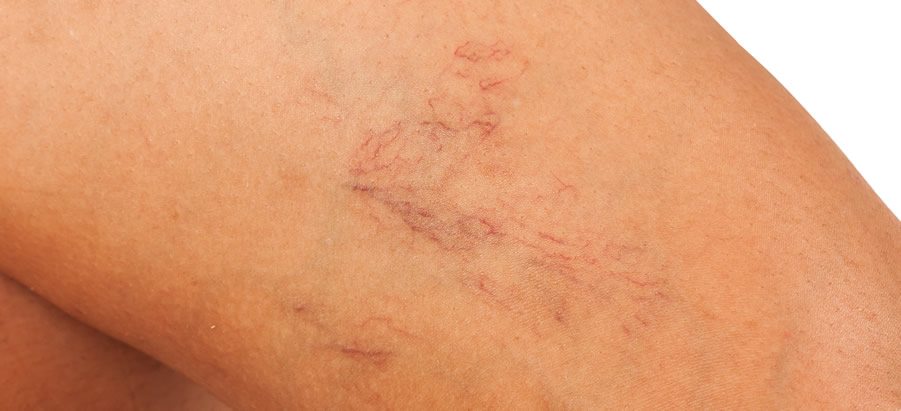Spider Veins
What are Spider Veins?

Spider veins appear as thin red, blue, and purple veins near the surface of the skin. Found right below the surface of the skin, they most often occur on the ankles, thighs, and calf area.
Also known as Telangiectasia, they are caused by the pressure of body weight, gravity, and the tough job of carrying blood back to the heart. Sometimes venous reflux occurs, which is the backup of blood in the leg.
Spider veins can also appear on the face, breasts, and feet.
Common Causes of Spider Veins
- The most common cause of spider veins is heredity.
- Gender plays a big role because women are much more likely to have this problem than men.
- Jobs or lifestyles that require long periods of time sitting or standing increase the risk tremendously.
- An injury or trauma to the legs can also be a contributing factor.
- Prolonged exposure to sunlight
- Further contributing factors may include obesity and pregnancy.
- The incidence of spider veins increases with age, and it is estimated that as many as 60% of adults may have spider veins.
Symptoms of Spider Veins
Spider veins don’t often pose any serious health problem and have few, if any symptoms except possibly some itchiness.
Sometimes individuals with spider veins experience a slight feeling of heaviness and tiredness in the legs. However, patients with many clusters of spider veins may actually experience symptoms similar to varicose veins.
This includes leg heaviness, aching, fatigue, as well as other symptoms. Though usually harmless, these veins can sometimes be a symptom of underlying varicose vein formation or poor circulation that may cause varicose veins in the future.
Treatment of Spider Veins
Visual Sclerotherapy is a commonly used treatment for spider veins. The vein specialist will inject the vein with a solution or a foam that will close the cause the vein to shrink and fade.
How to Prevent Spider Veins
There are a number of things you can do to help reduce the formation of spider veins such as quitting smoking, losing weight, and exercising.
You can also wear compression stockings or socks which come in a wide variety of designs and levels of compression.
Dr. Miller Answers Questions About Spider Veins
I have spider veins on my thighs, and my right leg. Are they related to varicose veins? Do they increase my risk of developing varicose veins?
I had an MRI of my knee, and the report said that I had varicose veins. Do I now need another MRI to see if I have varicose veins?
Although these images appear clear and distinct, they only offer a static image of the body’s anatomy, while offering no functional information. As a result, MRI currently has no role in diagnosing varicose vein disease. However, ultrasound, as a descendent of RADAR (which dates to WWII), which uses sound waves to image the body, can assist in diagnosing varicose veins.
With ultrasound, medical professionals can look at veins in real time, measure vein blood flow rates, and grade how much and precisely where vein reflux is present (backward flow, or reflux of blood within veins-as a result of damaged valves-is the driving factor in the development of varicose veins). The formal ultrasound examination necessary to properly diagnose varicose vein disease is painless, non-invasive, and usually takes about 45 minutes.
I had a doctor inject my spider veins in both legs. I had to go back for several treatments, which were very painful. Despite these injections, I continue to develop new spider veins. Is this common?
Spider veins are often fed by a complex network of deep venous structures, with the visualized spider vein being the “tip of the iceberg”. If spider vein therapy is approached by identifying and treating the vessels feeding or supplying them, a far superior end result may be achieved, as this allows the source of the spider vein to be eliminated.
Using the analogy of a simple gardening challenge: a weed will continue to flourish if only the portion found above ground is removed and the roots are allowed to remain. As far as the pain associated with spider vein treatments, non-vascular specialists tend to use sodium chloride for sclerotherapy (which is notorious for being quite painful).
Alternatives include detergent-like foaming compounds, which are not considered painful. Physicians trained in diagnosing and treating varicose veins and peripheral venous disease can offer patients the best treatment options available.

